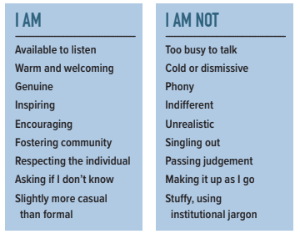
Are you excited to have students on your campus? Do you believe in them? Are you there to help? And does your messaging reflect the answers to those questions?
At Central Oregon Community College, the answer is a resounding YES. With a focus on student-centric communications, COCC has revamped their student onboarding process to ensure that emails, texts, social media posts and phone calls are infused with an
intentional, positive, and supportive tone.
“As part of our SEM work we reviewed our enrollment funnel to see where we were losing students and we were amazed at the number who got through the process — application, advising, placement — and never registered,” said Alicia
Moore, Vice President of Student Affairs.
Discovering this hole in conversion rates helped COCC determine where to put their efforts in a low-cost, high-impact way.
“We were doing a great job wooing prospects, but the moment they were admitted, our communication shifted to technical, business-like speak,” she said. “We decided we needed to carry the same message used during the recruitment cycle
throughout the entire enrollment process.”
Toward that end, the campus collaborated to produce a concise, practical, and example-driven Student Communications Style Guide that would emphasize the unique character and message of COCC.
Defining voice and persona
Staff interaction with students plays a critical role in student success, the Guide notes. The tone and tenor of staff responses must be consistent, conveying the following qualities:
Welcoming
Friendly
Approachable
Supportive/Encouraging
Energetic
Knowledgeable
Empathetic
Inclusive
Reassuring
Responsive
Empowering
COCC staff don’t have to guess about how to implement this voice. The Guide includes examples of each of the following common forms of communications: mass email, response email, financial aid email, acceptance letter, web page, and digital
post (text message, Facebook, Instagram). The wide array of samples demonstrates that the voice can be conveyed in a short message, such as a text or Tweet, or in longer, more prescriptive and detailed letters.
The Guide also offers alternative reactions to difficult situations. The below “I am/I am not” grid helps flesh out this persona.

Already the shift has led to increased yield.
“While we didn’t change all communications immediately, even minor changes brought a bump in conversion rates,” said Tyler Hayes, Director of Admissions/Registrar. “Even with the initial changes, we saw a two percent increase in
conversion from application to registration.”
Keys: leadership, collaboration, training
“This comprehensive effort to create a good student experience requires the dedication of institutional energy from a leadership level down,” Moore said. “And collaboration is also critical. We are an institution with a long history
of ‘playing well in the sandbox together,’ and our College Relations and Admissions Marketing (CRAM) team meets every week.”
Once the voice was established, staff training was crucial.
“The Guide has been well received,” Moore said. “Staff love having a common language and specific guidance regarding multiple modes of communication.”
The Guide has been so successful that offices not involved with student onboarding, such as student life and diversity and inclusion, are starting to rewrite their communications using early success as inspiration.
Learn more
Moore and Hayes will share the Guide, the process of developing it, and details about training and implementation in their session "Student Communications Planning: Tips and Tricks for Developing Student-Centric Communications" at AACRAO’s SEM Conference.
Learn more about "Transforming SEM" at the virtual AACRAO SEM Conference, October 28-30, 2020. Early bird registration extended through this Friday, October 9.